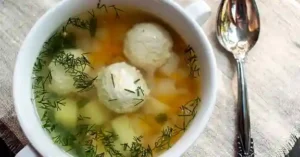Cuban chicken soup, known as Sopa de Pollo, is more than just a meal. It’s a comforting bowl of warmth, flavor, and tradition. This hearty soup combines tender chicken, fresh vegetables, and simple seasonings to create a dish that feels like home. In Cuban households, it’s a go-to recipe for family gatherings, celebrations, or when someone needs a little extra comfort. Whether you’re craving something nourishing or exploring Cuban flavors for the first time, this recipe will guide you step by step.

Introduction to Cuban Chicken Soup Recipe (Sopa de Pollo)
Cuban chicken soup, or Sopa de Pollo, is a beloved comfort food across Cuban households. It’s more than just a bowl of soup — it carries memories of family dinners, holiday gatherings, and the warmth of home cooking. In Cuban culture, this dish is often made when someone is feeling under the weather or when loved ones come together to share a meal. Its rich broth, tender chicken, and mix of vegetables create a flavor that is both simple and deeply satisfying.
What sets Cuban chicken soup apart from other chicken soups is its use of traditional ingredients like malanga (a root vegetable), fideo noodles, and a blend of spices that give the broth a unique depth. Some families add corn on the cob or pumpkin for extra heartiness, while others keep it light with just chicken, noodles, and vegetables.
This recipe has many variations, passed down from abuelas to their grandchildren, each with its own touch. But no matter how it’s prepared, the essence remains the same — nourishing, flavorful, and made with love. If you’re looking to try an authentic Cuban chicken soup recipe, you’re about to learn everything from the essential ingredients to cooking tips, variations, and serving suggestions.

Ingredients You’ll Need
Making a traditional Cuban chicken soup recipe starts with simple, wholesome ingredients. Each element plays a role in building layers of flavor and comfort. Below is a breakdown of the essentials, along with notes and substitutions you can try.
Main Ingredients
- Chicken: Bone-in chicken (such as thighs, drumsticks, or a whole chicken cut into pieces) gives the broth its rich flavor. If you prefer, you can use boneless chicken, but bones add more depth.
- Vegetables: Common choices include carrots, potatoes, celery, and onion. These create the hearty base of the soup.
- Garlic: Fresh garlic cloves add a bold, aromatic flavor that defines Cuban cooking.
- Tomato (optional): Some versions add fresh tomato or tomato paste for extra richness.
Traditional Cuban Additions
- Malanga: A starchy root vegetable often found in Cuban soups. It adds creaminess to the broth. If unavailable, you can use taro or extra potatoes as a substitute.
- Corn on the cob: Cut into chunks and added to the soup for a touch of sweetness.
- Pumpkin (calabaza): Brings a slightly sweet, earthy flavor that balances the savory broth.
- Fideo noodles or thin pasta: Classic in sopa de pollo. Vermicelli or angel hair pasta broken into short pieces also works well.
Seasonings and Flavor Enhancers
- Bay leaves: Infuse a subtle herbal flavor.
- Cilantro or parsley: Fresh herbs add brightness and balance.
- Chicken bouillon (optional): Intensifies the flavor if you want a stronger broth.
- Salt and pepper: Essential for seasoning to taste.
- Lime wedges (for serving): A squeeze of lime at the end brightens the whole dish.
Substitution Ideas
- For chicken: Use turkey for a slightly different but still hearty flavor.
- For noodles: Rice can replace pasta if you prefer a gluten-free version.
- For malanga: Swap with yucca or extra potatoes if you can’t find it locally.

Equipment for the Recipe
Cooking Cuban chicken soup doesn’t require fancy tools, but using the right equipment makes the process easier and ensures the best results. Below are the essentials you’ll want to have ready before you start:
Essential Cooking Equipment
- Large Soup Pot or Dutch Oven: A heavy-bottomed pot is perfect for simmering the chicken and vegetables slowly, allowing the flavors to blend. A cast iron Dutch oven is ideal because it holds heat evenly and keeps the broth rich.
- Cutting Board and Sharp Knife: Needed for prepping chicken, chopping vegetables, and cutting herbs.
- Wooden Spoon or Ladle: For stirring and serving the soup. A ladle makes it easy to dish out broth and chunky vegetables together.
- Measuring Cups and Spoons: Helpful for getting the right balance of spices, noodles, and broth.
Optional but Helpful Tools
- Instant Pot or Pressure Cooker: Speeds up cooking time while still producing a flavorful broth. Great for busy weeknights.
- Skimmer or Fine Mesh Strainer: Useful for removing foam or impurities from the broth as the chicken cooks. This helps achieve a clear, clean soup.
- Tongs: Handy for lifting out chicken pieces when it’s time to shred or debone them.
- Storage Containers: Airtight containers make it easy to store leftovers in the fridge or freezer.

How to Make Cuban Chicken Soup
Cooking Cuban chicken soup is all about layering flavors and letting the ingredients shine. Below is a detailed, step-by-step guide for both stovetop and Instant Pot methods.
Stovetop Method (Traditional Way)
Prepare the Chicken and Vegetables
Rinse chicken pieces and pat dry. Peel and chop carrots, potatoes, malanga (if using), and pumpkin into chunks. Slice celery, mince garlic, and chop onion.
Build the Base Flavor
Heat a little oil in a large soup pot or Dutch oven over medium heat. Add onion, garlic, and celery, sautéing until fragrant and lightly golden.
Simmer the Broth
Add chicken pieces to the pot along with enough water or chicken broth to cover. Drop in bay leaves, a pinch of salt, and pepper. Bring to a boil, then reduce heat to low. Skim off any foam that rises to the surface for a clear broth.
Add Vegetables
After about 30 minutes of simmering, add carrots, potatoes, malanga, pumpkin, and corn (if using). Continue cooking until vegetables are tender and chicken is cooked through (about 45–60 minutes total).
Add Noodles and Herbs
About 10 minutes before finishing, stir in fideo noodles (or broken angel hair pasta). Add chopped cilantro or parsley for freshness.
Finish and Serve
Remove chicken pieces, shred the meat, and discard bones and skin. Return shredded chicken to the pot. Taste and adjust seasoning with more salt, pepper, or bouillon if desired. Serve hot with lime wedges on the side.
Instant Pot Method (Faster Version)
Sauté Base Ingredients
Turn on Sauté mode, add a little oil, then cook onion, garlic, and celery until fragrant.
Add Chicken and Broth
Place chicken pieces in the pot. Pour in broth or water to cover. Add bay leaves, salt, and pepper.
Pressure Cook
Secure the lid and cook on High Pressure for 15 minutes. Let pressure release naturally for 10 minutes, then do a quick release.
Add Vegetables and Noodles
Open the pot, add carrots, potatoes, malanga, pumpkin, and corn. Cook on High Pressure for 5 minutes more. Switch back to Sauté mode, stir in noodles, and cook until tender (about 5 minutes).
Finish
Shred chicken, return it to the pot, and stir in herbs. Adjust seasoning to taste before serving.
Cooking Notes
- Clear broth tip: Always skim foam during the first simmer (stovetop) or strain broth if needed after pressure cooking.
- Texture control: Add noodles last so they don’t get mushy.
- Flavor boost: A splash of lime juice right before serving brings the soup to life.

Recipe Variations & Substitutions
One of the beautiful things about Cuban chicken soup (sopa de pollo) is how flexible it can be. Every family has its own way of preparing it, and you can easily adapt the recipe to fit your taste, dietary needs, or the ingredients you have on hand. Below are some popular variations and smart substitutions.
Traditional Cuban Variations
- With Malanga or Yucca: Many Cuban households add malanga or yucca for a creamy, earthy flavor. These root vegetables thicken the broth naturally.
- With Corn on the Cob: Cutting ears of corn into chunks and adding them to the pot gives the soup a touch of sweetness and makes it feel more rustic.
- Pumpkin (Calabaza): Adding pumpkin not only enhances the flavor but also deepens the color of the broth, making it rich and hearty.
Modern or Regional Twists
- Rice Instead of Noodles: If you prefer a gluten-free option, replace noodles with white rice. It absorbs the broth and makes the soup even more filling.
- Instant Pot Cuban Chicken Soup: A faster take on the traditional recipe. All the same flavors, but ready in less time.
- Spicy Kick: Though not traditional, you can add a little cayenne or fresh chili for a heat lovers’ version.
Protein Options
- Bone-In vs. Boneless Chicken: Bone-in chicken adds depth to the broth, but boneless chicken breasts or thighs make the recipe quicker and easier.
- Turkey or Pork Variation: Some families substitute turkey legs or pork bones for a different but equally comforting flavor.
Vegetable Swaps
- No Malanga?: Use extra potatoes, taro, or even sweet potatoes.
- Extra Veggies: Green beans, zucchini, or peas can be added for more color and nutrition.
Flavor Enhancements
- Bouillon Cubes: If your broth needs a stronger punch, add one or two bouillon cubes during cooking.
- Herbs: Cilantro is traditional, but parsley or even culantro (common in Latin cooking) work beautifully.
- Citrus Finish: Lime juice at the end brightens the soup, but you could also try a touch of lemon for a slightly different twist.

Pro Tips & Tricks for the Best Flavor
Cuban chicken soup is simple, but the secret to making it unforgettable lies in the little details. These pro tips will help you get a rich, flavorful broth and a perfectly balanced bowl of sopa de pollo every time.
Start with Bone-In Chicken
Bone-in pieces like thighs, drumsticks, or a whole chicken cut into parts give the broth depth and richness. The marrow and skin release natural flavor and nutrients. If you prefer boneless, add a little chicken bouillon to make up for the lost flavor.
Sauté Aromatics First
Don’t skip the step of lightly sautéing onion, garlic, and celery before adding water or broth. This step builds a flavorful foundation that makes a big difference.
Skim for a Clear Broth
When cooking on the stovetop, foam will rise to the top as the chicken simmers. Skim it off with a spoon or skimmer for a clean, golden broth.
Add Vegetables in Stages
Dense vegetables like potatoes, malanga, or pumpkin go in earlier since they need more time to cook. Noodles and fresh herbs should be added at the very end so they don’t overcook or lose freshness.
Season Gradually
Salt the soup lightly at the beginning and adjust toward the end. This prevents the broth from becoming too salty as it reduces. A touch of bouillon or chicken stock concentrate at the end can boost flavor if needed.
Don’t Overcook the Noodles
Add noodles only in the last 8–10 minutes. If left too long, they’ll soak up too much broth and turn mushy.
Finish with Freshness
A squeeze of lime juice right before serving brightens the flavors and balances the richness of the broth. Sprinkle fresh cilantro or parsley over each bowl for a vibrant finish.
Common Mistakes to Avoid
- Boiling instead of simmering: Boiling makes the broth cloudy and the chicken tough. Always simmer gently.
- Crowding the pot with too many noodles: It’s tempting to add more, but they expand and can overwhelm the soup.
- Skipping herbs: Fresh herbs are key to Cuban flavor—don’t leave them out.

Serving Suggestions
Cuban chicken soup (sopa de pollo) is hearty enough to be enjoyed on its own, but the right accompaniments can turn it into a complete and satisfying meal. In Cuban households, it’s often served with simple sides and garnishes that balance the flavors and add extra comfort.
Traditional Cuban Pairings
- White Rice: A classic side dish that complements the soup perfectly. Many families spoon the soup right over the rice for extra heartiness.
- Cuban Bread or Toasted Baguette: Light and crusty bread is perfect for soaking up the flavorful broth.
- Tostones (Fried Plantains): Crispy plantain rounds add a savory, salty crunch alongside the warm soup.
- Avocado Slices: Creamy avocado balances the acidity of lime and adds freshness.
Garnishes to Brighten the Soup
- Fresh Cilantro or Parsley: Chopped herbs sprinkled on top for color and flavor.
- Lime Wedges: A squeeze of lime at the table enhances the soup’s brightness.
- Hot Sauce (Optional): While not traditional, some enjoy a dash of hot sauce for extra kick.
Serving Style Ideas
- Family-Style Meal: Place the pot of soup at the center of the table, with sides like rice, bread, and plantains served separately. Each person can customize their bowl.
- Comfort Food Bowl: Serve the soup in large bowls with a generous portion of chicken, noodles, and vegetables, and pair with just bread or crackers for a simple, cozy meal.
- Party or Gathering: Make a big batch and serve smaller bowls of soup as a starter before a Cuban feast featuring dishes like ropa vieja or arroz con pollo.
When to Serve
- Everyday Comfort: Ideal for lunch or dinner, especially on cooler days.
- Healing Soup: A go-to dish when someone in the family feels sick or needs a pick-me-up.
- Celebrations: Many families prepare sopa de pollo during holidays or festive gatherings as a reminder of tradition and togetherness.

Storage & Leftover Tips
Cuban chicken soup is one of those dishes that tastes even better the next day as the flavors continue to develop. Storing it properly ensures you can enjoy it again without losing taste or texture. Here’s how to handle leftovers the right way.
Refrigeration
Allow the soup to cool to room temperature before storing. Transfer to an airtight container to keep it fresh. Refrigerate for up to 3–4 days.
- Tip: If you’ve added noodles, they may continue to absorb liquid and become soft. To avoid this, cook noodles separately and add them only when reheating.
Freezing
For long-term storage, portion the soup into freezer-safe containers or heavy-duty freezer bags. Freeze for up to 2–3 months. Leave a little space at the top of containers, since the liquid will expand when frozen.
- Tip: It’s best to freeze the soup without noodles or fresh herbs. Add those later when reheating for the best texture and flavor.
Reheating
- Stovetop: Place the soup in a pot and warm over medium heat until hot, stirring occasionally. Add a splash of broth or water if it has thickened too much.
- Microwave: Heat individual portions in a microwave-safe bowl, covered, in 1–2 minute intervals until hot. Stir between intervals for even heating.
- From Frozen: Thaw overnight in the fridge before reheating. For a quicker option, place the frozen container under warm water to loosen, then reheat gently on the stovetop.
Tips for Best Flavor
Add freshly chopped cilantro or parsley after reheating for brightness. If the broth tastes flat, refresh it with a squeeze of lime juice or a pinch of bouillon. Cook fresh noodles separately and stir them in just before serving.

Nutrition & Health Benefits
Cuban chicken soup (sopa de pollo) isn’t just flavorful—it’s also packed with nutrients that make it a wholesome and healing dish. From its lean protein to its vitamin-rich vegetables, every bowl offers comfort with a nutritional boost.
High in Protein
Chicken provides lean protein that supports muscle health and helps keep you full. Using bone-in chicken also enriches the broth with collagen, which is great for joint and skin health.
Rich in Vitamins & Minerals
Carrots add vitamin A for eye health and immune support. Potatoes and malanga provide potassium, which helps regulate blood pressure. Pumpkin (calabaza) brings vitamin C, beta-carotene, and antioxidants. Corn offers fiber and natural sweetness that balances the soup.
Immune-Boosting Properties
The warm broth is hydrating and soothing, making it a go-to when someone feels under the weather. Garlic and onions have natural antibacterial and antiviral compounds, often considered healing in traditional cooking.
Balanced Meal in a Bowl
With protein (chicken), complex carbs (vegetables and noodles or rice), and healthy fats (if using a drizzle of olive oil), it’s a complete, balanced dish. Lime juice and fresh herbs add antioxidants and brightness without extra calories.
Light Yet Filling
Unlike creamy soups, Cuban chicken soup is broth-based, making it lighter while still satisfying. Portion control is easy—you can enjoy a generous bowl without feeling overly heavy.
Diet-Friendly Adaptations
- Gluten-Free: Replace noodles with rice or skip them entirely.
- Low-Carb: Focus on chicken and vegetables, leaving out potatoes or pasta.
- Low-Sodium: Use homemade broth and season gradually to control salt levels.
Conclusion
Cuban chicken soup is the kind of recipe that brings people together around the table. Simple ingredients, slow simmering, and a touch of fresh herbs create a dish that feels both nourishing and comforting. Whether you prepare it the traditional way with malanga and corn or give it your own twist, this sopa de pollo will always deliver warmth in every spoonful. Try this recipe once, and it just might become your go-to comfort meal for family gatherings, chilly evenings, or whenever you need a taste of home.
FAQS

Cuban Chicken Soup Recipe
Ingredients
Method
- Place the chicken, onion, garlic, tomato, green bell pepper, two carrots and bay leaves in the pot of a 6-quart pressure cooker. Fill the pot with enough water to just cover the ingredients (roughly 8 cups of water). Place the lid of the pressure cooker on the pot, locking it in place and adjusting the pressure valve according to manufactures instructions. Once pressurized, cook for 30 minutes.
- Once the 30 minutes has passed, allow the pressure cooker to depressurize. Strain the contents of the pot using a fine mesh sieve. Take extra care to ensure that small pieces of bone are left behind. Reserve the chicken for use in another meal.
- Return the stock to the pot of the pressure cooker and bring to a boil. Add the garlic powder, onion powder, cumin, sazon, potatoes, sliced carrot, malanga, and fideos to the pot. Continue to cook the soup until the potatoes, malanga and fideos are cooked through.
